

A total solar eclipse was scheduled to cross the continental United States on 21 August 2017. This was the first solar eclipse anywhere in the US in almost four decades, and the first one that was widely viewable across the entire country in the last 99 years. I remember spotting this date on the calendar sometime in the early 2000s, and thinking that I'd like to go see the eclipse when it happened, hoping that I'd be in a position to do so. When the date finally began to approach this year, I realized that I was indeed fortunate enough to see the celestial event take place. The eclipse was taking place on a Monday and I could take off work for one day to watch it happen. The result was a strange day of long travel sandwiched around the amazing experience of watching the eclipse itself play out in the skies above. It's not often that you have the opportunity to watch the sun rise and set twice in a single day! I'm writing this short recap of my experience on the Tuesday following the eclipse so that I can record my thoughts before the memories begin to fade.
One of the most important things to keep in mind with regards to a solar eclipse is whether it will be a partial eclipse or a total eclipse. The partial eclipse is viewable in a much wider area, and in this case almost all of the North American continent was in a position to watch it. I could have stayed at home and seen a partial eclipse that would cover up about 80% of the sun's surface. Total eclipses are much harder to see, however, since there is only a narrow area where the moon's surface will completely block out the sun's light. For this eclipse, the totality would take place in a narrow band about seventy miles wide stretching in a diagonal line from northwest to southeast, beginning in Oregon and running across the US until reaching the South Carolina coast. If I wanted to see the total eclipse, I would need to travel somewhere in that narrow band and be there before the big show in the sky began. Further complicating matters, any cloud cover can block a viewing of the eclipse. A rainy day or even a big white puffy cloud in the wrong place at the wrong time could ruin the whole thing. The total eclipse would also only last for a very short period of time, roughly two minutes in duration. If I wanted to see the total eclipse, I needed all of these factors to line up in the correct way at the correct time. This was going to take both good planning and good luck.

The first question where was to travel to view the eclipse. Based on my home location in the northern suburbs of Washington DC, the only practical choice was somewhere in the state of South Carolina. That was close enough that I could drive down and back in a single day, albeit with some very long hours of driving. My initial plan was to visit Santee National Wildlife Refuge, a park to the southeast of Columbia, due to its easy proximity to Interstate 95. However, by the time that the day before the eclipse rolled around, the local weather forecast was predicting a high concentration of clouds in the southern part of South Carolina. The weather was expected to be clearer in the upstate region, and I cast around for another location to view the eclipse. Eventually I settled on Greenville, a moderately sized city that was smack in the middle of the totality's path. There was a little river that ran through the center of town, and a riverwalk named Falls Park that accompanied it. I knew that there would be a viewing party for the eclipse there, and it seemed like a good place to watch the heavenly show with a crowd of people.
Unfortunately, Greenville wasn't particularly close to where I lived. According to Google Maps, it was a journey of 510 miles (about 815 kilometers) away and would require 8 hours of driving to reach... each way. And even that was surely being optimistic, as the roads in the area would be packed with other travelers coming to see the eclipse. The event itself would be taking place around 2:30 PM, and I needed to be there ahead of time to avoid rendering this entire exercise pointless. I decided that I would leave at 3:00 AM to be on the safe side, bypassing the morning traffic in Washington and Richmond, in the hopes of reaching the destination around noon and having a chance to get a prime viewing position before the eclipse began. Up for a roadtrip, anyone?
Readers of this travel blog likely know that I have no trouble waking early for travel purposes and I'm used to doing long drives while sightseeing. This journey proved to be especially difficult though, due to the distance involved and the number of other cars on the road. I had no trouble for the first seven hours of driving, taking advantage of the early hours to drive through Virginia and North Carolina while watching the sun slowly rise in the east. The driving became more difficult once I passed Charlotte, and particularly after I crossed the state line into South Carolina. Interstate 85 was packed with cars heading south to see the total eclipse, and there was mile after mile of stop and go traffic. I'll spare the tedious details and note only that it took about 2.5 hours to drive the 50 miles between the South Carolina border and the city of Greenville itself. The one neat thing was seeing the signs for several Revolutionary War battlefields (King's Mountain and the Cowpens) in the area, although of course I couldn't stop to check them out. Not on this trip anyway.

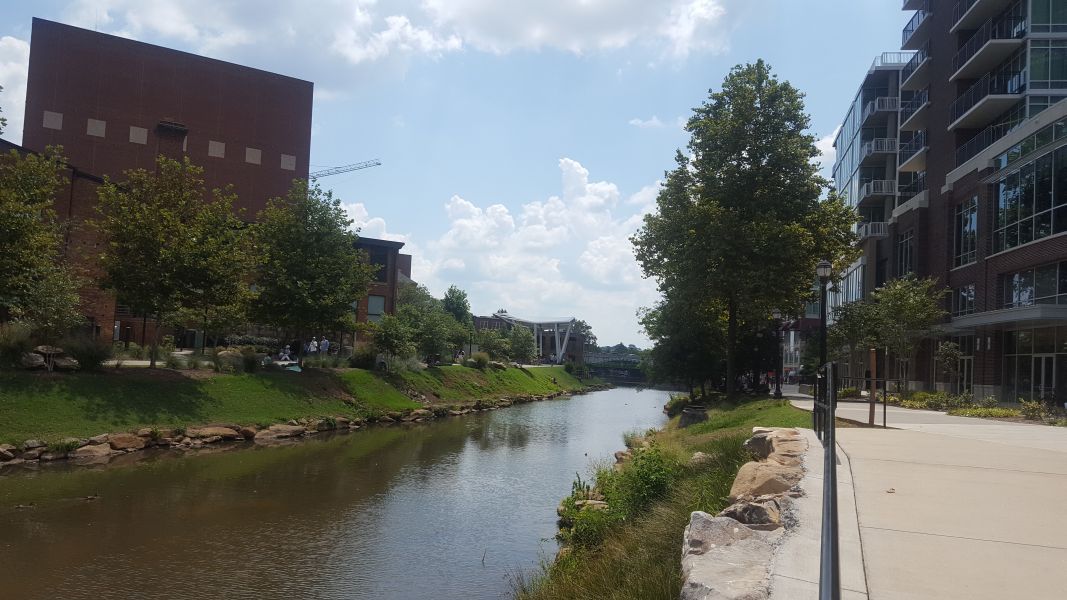


After parking in downtown Greenville, I walked the short distance to Falls Park and found a crowd already gathering. It was 1:00 PM and the eclipse was just beginning, although without looking directly at the sun itself there was nothing to say that an eclipse was underway. It was a beautiful day outside, with just a couple of white fluffy clouds in the sky that did nothing to block the view of the sun. That was a relief - it would have been a major disappointment to travel across four states and have the eclipse blocked by a random cloud. The only downside was the hot weather, which was roughly 95 F / 35 C. I wasn't exactly surprised by the heat though; it was August in South Carolina, after all. The crowd was in a festive mood all along Falls Park, with children running and playing, adults sunbathing, cameras snapping pictures everywhere, and several drones hovering up in the air. Aside from baking in the sun with no sunscreen, this was a perfect place to watch the eclipse.
I had two major regrets on this trip. One of them was failing to secure ahead of time a pair of the special sunglasses used for viewing eclipses. I had known this event was coming years in advance, and for whatever reason didn't think to order a pair of the sunglasses until a week before time, when all of them were of course sold out online.  That was pretty stupid, and although some of the nearby people allowed me to look through their sunglasses a couple times during the eclipse, it would have been better to have my own pair. The other regret was lacking a good camera to take some proper pictures. I had lost my beloved camera that I carried all across Alaska and Europe when I accidentally left it on the DC Metro, and I didn't have a replacement yet. I was forced to use my cell phone's little camera, which worked well enough for selfies but wasn't the proper tool for this event. Still, you can only use the resources that you have available, and these pictures were all taken with that camera.
That was pretty stupid, and although some of the nearby people allowed me to look through their sunglasses a couple times during the eclipse, it would have been better to have my own pair. The other regret was lacking a good camera to take some proper pictures. I had lost my beloved camera that I carried all across Alaska and Europe when I accidentally left it on the DC Metro, and I didn't have a replacement yet. I was forced to use my cell phone's little camera, which worked well enough for selfies but wasn't the proper tool for this event. Still, you can only use the resources that you have available, and these pictures were all taken with that camera.

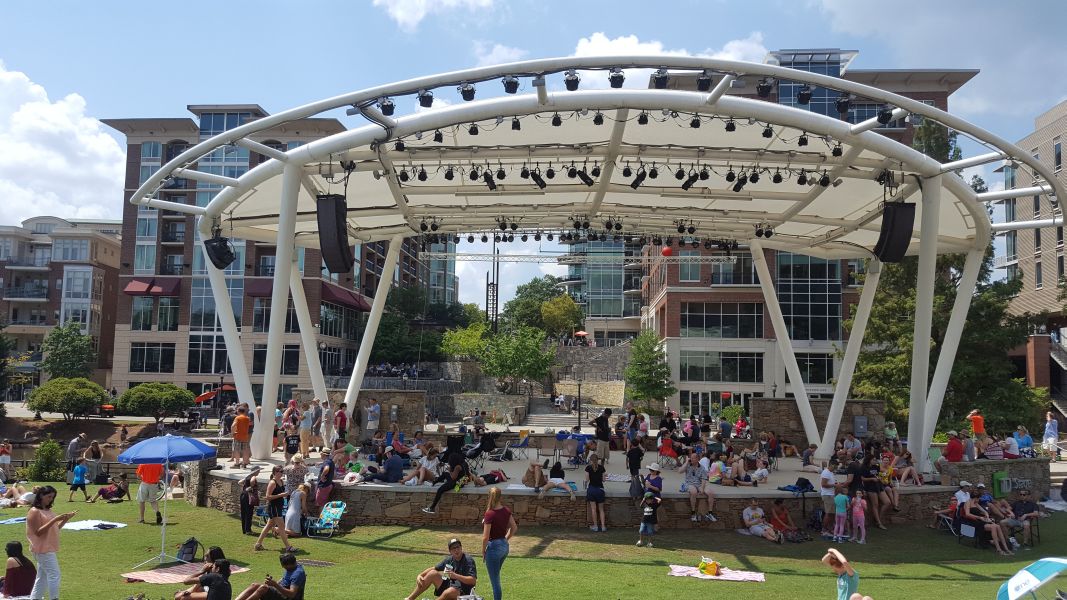


What is it like to view a total solar eclipse? I think the first thing to point out is how much DOESN'T change while the eclipse is in progress. Viewed through the special sunglasses, it was easy to see that the moon was starting to block out an increasing chunk of the sun's surface as the eclipse progressed. This was amazing to watch as it happened, and the sun began to go through the same phases that we usually see the moon experiencing over the course of a month, only playing out in an hour's span of time. It was bizarre to look up in the sky and see a crescent sun instead of a crescent moon. That simply doesn't happen at any other time and felt really, really strange to watch. However, even as the moon began to cover up more and more of the sun's surface, the light outside remained bright and looked essentially unchanged from any other day. Up until about eighty percent of the sun was blocked out, there was little in the way of discernible change outside.
It was the last 15 minutes before and after the total eclipse that things started to get weird. I overheard some of the people in the crowd mentioning that it felt cooler, and I realized that they were right. It definitely did feel cooler compared to a half hour earlier, about 10 to 15 degrees (Fahrenheit) cooler, like the way sitting in the shade will feel under normal circumstances. Only... we weren't in the shade, we were sitting right out in the open with the sun still shining. The temperature was diminishing because the moon was blocking out most of the sun's light and heat. Similarly, I had been getting that slightly toasty feeling on my arms and legs that comes from sitting outside on a hot day without sunscreen applied. I realized that that sensation had also vanished without my realizing it, and it really did feel like I was sitting in the shade. Very strange.

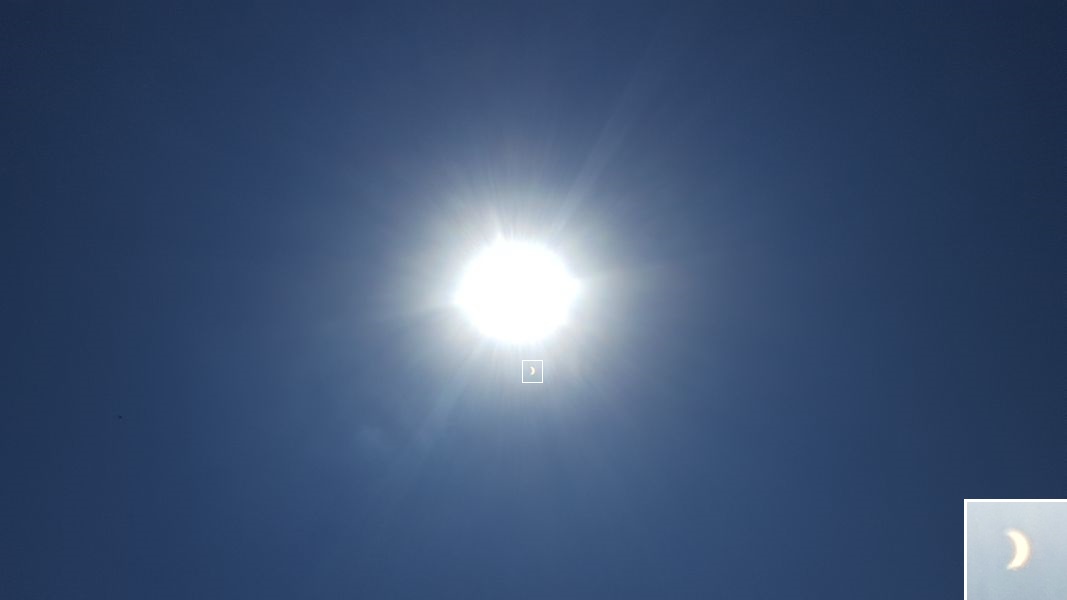


As the totality began to approach, the sunlight began to take on a different tint. It took on a slightly faded cast, the way that sunlight can look in the late afternoon when it's touching the horizon, and the colors in the riverside park started to look faintly washed out. However, the sun wasn't down near the horizon, it was still far up in the sky, and there was none of the orange glow that normally accompanies a sunset. The sun was simply getting dimmer, its light weakening as more and more of it was blocked out. Seen through the eclipse sunglasses, it was easy to tell that this was being caused by the moon blocking out the sun's surface. Without the sunglasses though, it was hard to see the moon at all. The sun simply looked pale and wan, like it was changing from a yellow star into a white dwarf. To be clear here, it didn't get dark even with the moon blocking out 95% of the sun's surface. Even that small amount of light kept everything in clear daylight, not night. But the light appeared to be fading and failing as the sun's glow weakened. In all honesty, this was downright frightening to watch. Despite full 21st century knowledge of the astronomy involved, it was hard to watch the sun slowly collapsing into darkness and not feel unnerved by it. There were a lot of people in the crowd making jokes about the end of the world, but they always sounded slighly uneasy when they said it. For premodern peoples watching a total solar eclipse, the experience would have been terrfying.

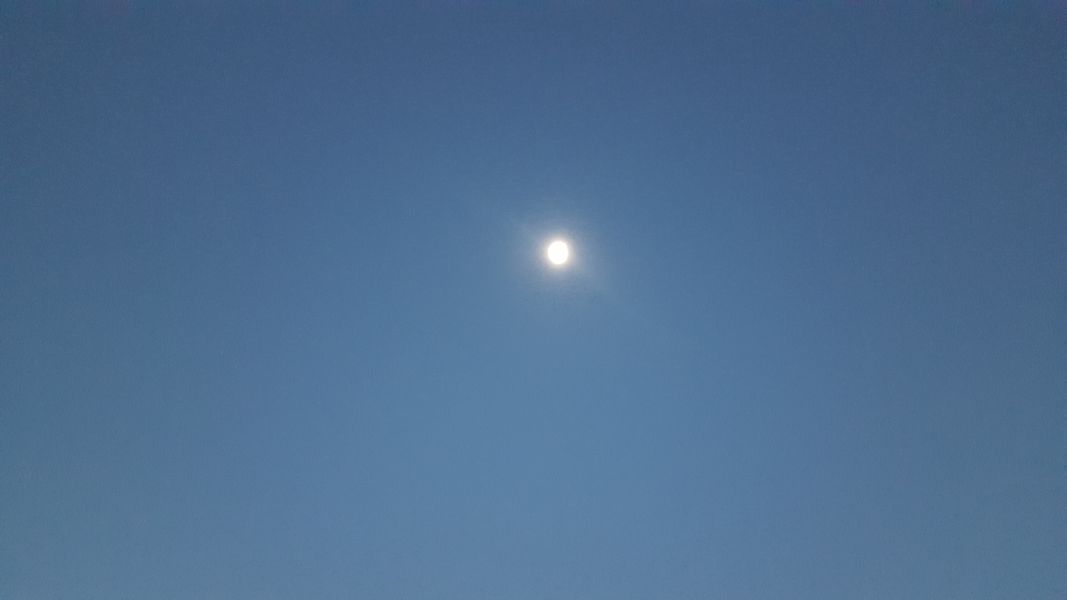


Finally, at 2:38 PM local time, the sun slipped completely behind the moon and we reached the full total eclipse. This is the one time when it's safe to look at the sun with any kind of eye protection, and I was able to see the event in its full glory. The total eclipse is beautiful beyond words, with the sun's corona providing a perfect halo of light ringing the moon. It looks like a normal sun with the colors reversed somehow, a disc of blackness with white light radiating out on every side. With the sun completely blocked, the area surrounding me fell into a very temporary night. All of the automatic streetlights came on to keep the place from getting too dark, and this was one more regret about the otherwise perfect spot that I had chosen to view the eclipse. Because I was in the middle of a city, there were too many artificial lights on all sides and it never truly became dark; I could only barely see the stars. If I have the chance to view another total eclipse, I'll try to find a spot out in the countryside where true night descends during the eclipse.

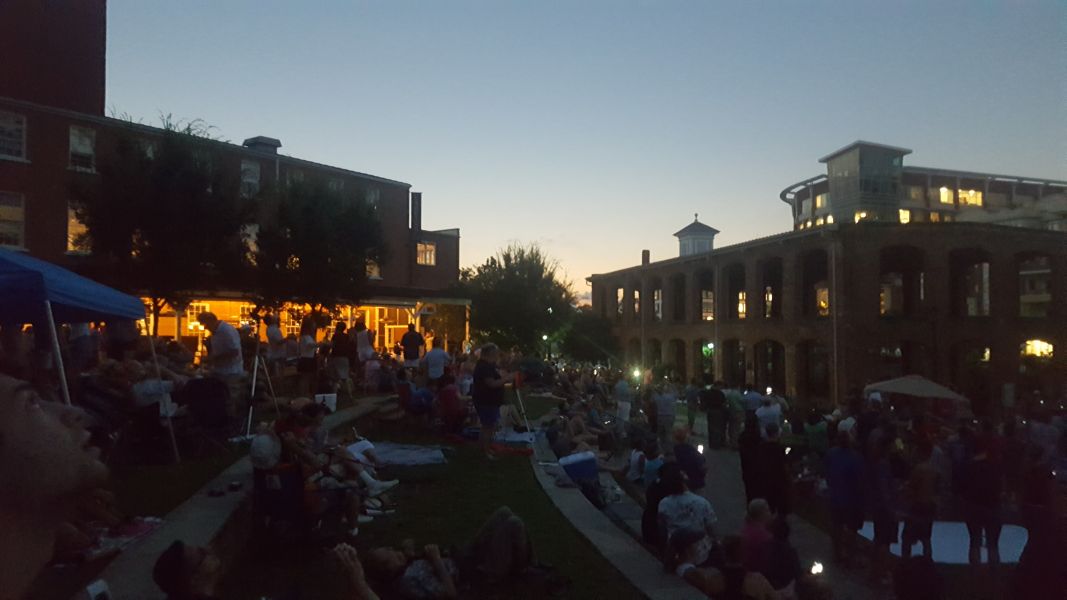
The whole thing only lasted for two minutes. The light on the right side of the moon started to glow with a particular intensity, and then sunlight burst free from that side and banished away the darkness. Now the eclipse proceeded again in reverse, with the sun gradually reclaiming more and more of its light over the course of the next hour before returning completely to its normal state. As much as the descent into darkness had been a scary experience, the return of the sun's glow was a surprisingly uplifting moment. I wasn't the only person in the crowd to find themselves tearing up unexpectedly at the renewal of the sun's energy. As for those two minutes of the total eclipse itself, I'm reasonably pleased with the pictures and video I was able to take during the brief window of time. However, as much of a cliche as it might be to write this, it's also true: pictures do not do the experience justice. You really do have to experience a total eclipse in person to get the full effect. Seeing the full eclipse in real time was more beautiful and mystifying than I can ever put into words. Dinky little pictures from a camera phone are a poor substitute indeed.

Of course, now I was still 500 miles away from home and needed to make the return journey. I was on the road again by 3:00 PM but I didn't manage to get very far. Traffic on Interstate 85 outside Greenville was total gridlock, and it took two hours to reach Spartansburg 25 miles away. I had been stuck in a lane with traffic barriers on both sides, crawling along in fits and starts, without even the ability to leave the interstate. I got out of that situation as quickly as possible and began plotting alternate routes with the use of Google maps. I wound up traveling between Spartansburg and Charlotte via a crazy series of twists and turns on country roads, bypassing the immobile traffic on the interstate through the use of local routes. This was much better than sitting in traffic endlessly, but it was still a slow process. The Eisenhower administration built the interstates specifically so that travelers don't have to wind around all those local roads. The net result was that I didn't get clear of the Charlotte area until about 6:30 PM, and while that was the end of any major traffic, I had another seven hours of driving ahead of me. On the drive back, I watched the sun set in the west just as I had earlier watched it rise in the east. The daily rhythms of our solar system were more on my mind today than they had been in a long time. Eventually I made it back home at 1:30 AM, completely exhausted and about to collapse. I had been awake for 22.5 hours and had spent 20 of them in the car driving. Then I woke up at 5:30 AM the next morning and worked my normal ten hour day, which wasn't exactly the most productive I've ever been there.
Was it worth all that travel time just to see a two minute eclipse? Of course it was!  Aside from the five hours I was stuck in traffic, I hadn't particularly minded the driving, with music and sports and audiobooks to listen to along the way. More importantly, seeing a total eclipse of the sun was the fulfillment of a lifelong goal, something that I had always wanted to experience. I've been fortunate enough now to see solar and lunar eclipses, the Midnight Sun, and the Northern Lights. The solar eclipse was the most impressive of the bunch, although a brighter and more colorful version of the aurora than the wispy ones that I saw would likely come close. I love to travel and see new things, and this was the ideal time to go and see an eclipse, before I had a family and small children to look after. If twenty hours of travel was the price to pay for a chance to experience the sublime, that was a small price to pay indeed.
Aside from the five hours I was stuck in traffic, I hadn't particularly minded the driving, with music and sports and audiobooks to listen to along the way. More importantly, seeing a total eclipse of the sun was the fulfillment of a lifelong goal, something that I had always wanted to experience. I've been fortunate enough now to see solar and lunar eclipses, the Midnight Sun, and the Northern Lights. The solar eclipse was the most impressive of the bunch, although a brighter and more colorful version of the aurora than the wispy ones that I saw would likely come close. I love to travel and see new things, and this was the ideal time to go and see an eclipse, before I had a family and small children to look after. If twenty hours of travel was the price to pay for a chance to experience the sublime, that was a small price to pay indeed.



